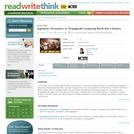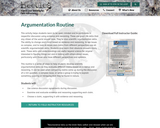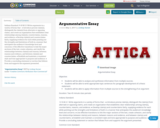
This resource is to introduce the writing of a thesis statement and introduction for a research essay.
- Subject:
- Arts and Humanities
- Material Type:
- Assessment
- Full Course
- Homework/Assignment
- Lecture
- Lesson Plan
- Reading
- Date Added:
- 11/08/2014

This resource is to introduce the writing of a thesis statement and introduction for a research essay.

Abstract
Arguing Through Writing is heavily adapted from the Lumen Learning English Composition 2 book on the SUNY OER list of texts. The textbook focuses on the writing process, as well as rhetorical modes. Emphasis is on the modes of causal analysis, argument, definition, and classification. MLA style and academic writing moves are featured. The textbook would be appropriate for either college-level Composition 1 or 2. The text features readings for each of the modes, as well as historical and contemporary texts in a reader section. The original version of this book was released under a CC-BY license and is copyright by Lumen Learning. It was then developed in March 2020 by Joshua Dickinson, Associate Professor of English at Jefferson Community College in Watertown, NY. The changes to this book listed are released under a CC-BY-SA license and are copyright by Joshua Dickinson of Jefferson Community College in Watertown, NY.
Description
Arguing Through Writing covers college-level writing, basic research, and argumentation with a combination of contemporary, historical, and classical writing models. The text focuses on classification, definition, causal analysis, and argumentation, working with these writing modes and pairing those with relevant texts. Several chapters are devoted to playing the writing game and knowing its moves. Visual arguments, MLA style, preparing annotated bibliographies, and film analysis are covered. The reader includes selections from Michel de Montaigne, Steven Pinker, H. G. Wells' history, Flannery O'Connor, Martin Luther King Jr., Ralph Waldo Emerson, Gordon Allport, and Stephen Leacock.
URI
http://hdl.handle.net/1951/71291

There is a quote that has been passed down many years and is most recently accounted to P.T. Barnum, “There is a sucker born every minute.” Are you that sucker? If you were, would you like to be “reborn?” The goal of this book is to help you through that “birthing” process. Critical thinking and standing up for your ideas and making decisions are important in both your personal and professional life. How good are we at making the decision to marry? According to the Centers for Disease Control, there is one divorce in America every 36 seconds. That is nearly 2,400 every day. And professionally, the Wall Street Journal predicts the average person will have 7 careers in their lifetime. Critical thinking skills are crucial.

Argument is a familiar concept to most people; however, to win an argument, or at least, to argue points effectively is not so easy. In this seminar, you will learn the basic concepts surrounding argument and, in turn, develop an argument utilizing components that set you up for success. Remember, argument does not mean yelling at someone because you think you’re right; argument refers to logical thinking with clear points, building toward a specific outcome.StandardsCC.1.2.9-10.H: Delineate and evaluate the argument and specific claims in a text, assessing the validity of reasoning and relevance of evidence.CC.1.4.9-10.C: Develop and analyze the topic with relevant, well-chosen, and sufficient facts, extended definitions, concrete details, quotations, or other information and examples appropriate to the audience’s knowledge of the topic; include graphics and multimedia when useful to aiding comprehension.CC.1.4.9-10.G: Write arguments to support claims in an analysis of substantive topics.

Argument is a familiar concept to most people; however, to win an argument, or at least, to argue points effectively is not so easy. In this seminar, you will learn the basic concepts surrounding argument and, in turn, develop an argument utilizing components that set you up for success. Remember, argument does not mean yelling at someone because you think you’re right; argument refers to logical thinking with clear points, building toward a specific outcome.StandardsCC.1.2.9-10.H: Delineate and evaluate the argument and specific claims in a text, assessing the validity of reasoning and relevance of evidence.CC.1.4.9-10.C: Develop and analyze the topic with relevant, well-chosen, and sufficient facts, extended definitions, concrete details, quotations, or other information and examples appropriate to the audience’s knowledge of the topic; include graphics and multimedia when useful to aiding comprehension.CC.1.4.9-10.G: Write arguments to support claims in an analysis of substantive topics.

In this learning area, you will learn how to develop an argumentative essay and stronger critical thinking skills. This learning area will help you develop your arguments, understand your audience, evaluate source material, approach arguments rhetorically, and avoid logical fallacies. Here, you’ll also learn about evaluating other arguments and creating digital writing projects related to your argument.

Multiple stages (outline, draft, revise) of an argument essay assignement.

This resource is useful for some general information about argument essays and how to organize them.

Basic purpose and organization of a five-paragraph, argument essay. Audience: Community College Transitional English Instructors.

This assignment covers Titles, Title Images, Introduction to Easybib, Research and the Argument Essay, bias and Positive Tone.What is the difference between a simple Research Paper and an Argument Essay/Position Paper? Your opinion based on the factual evidence you researched.Let’s do this in 6 sentences.An Argument Essay in 6 Sentences

Students analyze World War II posters, as a group and then independently, to explore how argument, persuasion and propaganda differ.

A checklist used by teachers to assess high school students’ argumentation skills.

A checklist used by teachers to assess middle school students’ argumentation skills.

This activity helps students learn to be open-minded and to participate in respectful discussion using evidence and reasoning. These are great life skills that any citizen of the world should have. They’re also scientific argumentation skills. The ability to change one’s mind based on evidence and reasoning, to see issues as complex, and to look at issues and claims from different perspectives are all scientific argumentation skills. Students also learn that absolute answers rarely exist. These skills and understandings are useful beyond science for anyone interested in figuring things out and in talking with others about issues, particularly with those who have different perspectives and opinions.

A rubric in student language used by high school students to create an argument that meets high standards of quality.

This Communication and Argumentation seminar is an intensive writing workshop that focuses on argumentation and communication. Students learn to write and present their ideas in cogent, persuasive arguments and other analytical frameworks. Reading and writing assignments and other exercises stress the connections between clear thinking, critical reading, and effective writing.

Indiana Standard:
9-10.W.3.1 Write arguments in a variety of forms that – ● Introduce precise claim(s), distinguish the claim(s) from alternate or opposing claims, and create an organization that establishes clear relationships among claim(s), counterclaims, reasons, and evidence. ● Develop claim(s) and counterclaims fairly, supplying evidence for each while pointing out the strengths and limitations of both in a manner that anticipates the audience’s knowledge level and concerns. ● Use effective transitions to link the major sections of the text, create cohesion, and clarify the relationships between claim(s) and reasons, between reasons and evidence, and between claim(s) and counterclaims. ● Establish and maintain a consistent style and tone appropriate to purpose and audience. ● Provide a concluding statement or section that follows from and supports the argument presented.

A quick overview of how to structure body paragraphs in an argumentative essay with assignment.

Explanations and exercises about the use of counterarguments and concessions in argumentative essays.

Explanation and overview of the argumentative or persuasive essay. 9-minute video.